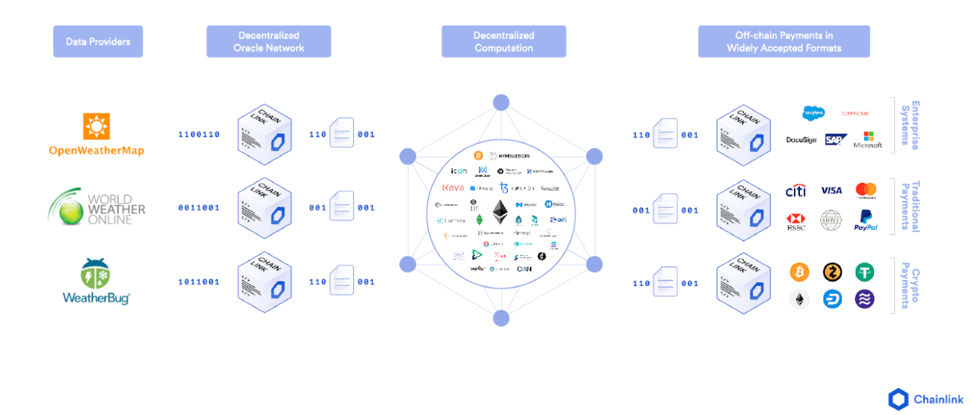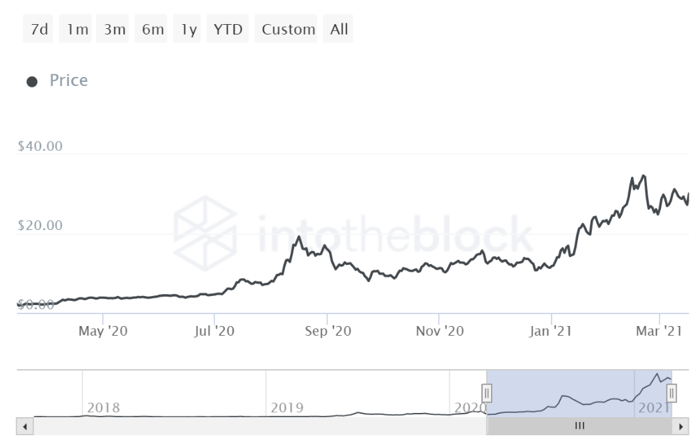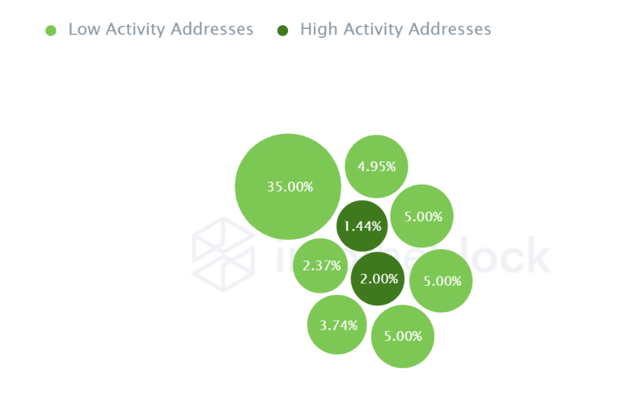Blockchains add value with highly secure protocols, but in order to improve them an expansion on smart contract closed-end systems is needed. While this expansion introduces new problems, Chainlink is here to offer a solution.
Key Insights:
- LINK price soars 9% as Grayscale Investment invests in LINK among four other cryptos.
- Chainlink is solving the ''Oracle Problem'' via decentralized oracles.
- Chainlink has real world applications in stablecoins, decentralized exchanges, money markets, and many more segments.
- Some of the driving forces behind a rising LINK token price are LINK ownership dynamics and HODLers, Grayscale Investment, and Bitcoin correlation.
What is an oracle in blockchain?
Oracles are the grease to the blockchain motor. They facilitate the flow of data between the blockchain’s input and output ecosystem. The image below summarizes how Chainlink wedges its oracle technology between external data events, such as a weather forecast, a decentralized platform such as Ethereum, and the off-chain users of said platform.

Imagine a natural disaster occurs in Texas, and multiple weather agencies report data. Oracles can aggregate this external weather data, which come from different systems, and funnel it back to a given smart contract. This given smart contract, is an insurance company’s smart contract and executes payments to victims of the most affected areas of said disaster only if certain weather data criteria are met. If criteria is validated by the smart contract, then payments are executed.
Without Chainlink, the step where the smart contracts aggregate multiple data from different systems is currently prone to failures. Why? Because blockchains are like black boxes with no built-in ability to connect with the outside world and because centralized oracles welcome threats. Chainlink solves something called the ‘‘Oracle problem’’.
What is the ‘‘oracle problem’’?
Chainlink develops a technology called ‘‘middleware’’, or to be more specific, a technology that helps weave useful external data and smart contracts together dynamically. Middleware in blockchain lingo is the technology that allows smart contracts, the software used to make decentralized applications, to connect with the outside world.
The outside world, or external events, are usually represented in large foreign data sets. These data sets don’t originate in a given blockchain, but nodes (users) on a blockchain might want to use this data to invent new applications. In developing a dynamic middleware, Chainlink is solving the ‘‘oracle problem’’ or the ‘‘smart contract connectivity problem’’ which we explain next:
Simply, the oracle problem is the duality between expanding smart contract systems while controlling for security risk.
The shortcoming with current smart contracts is that they have a really hard time knowing about outside events because they are coded in an enclosed system. External events related to changes in financial markets for example, are hard to weave into smart contracts because a given market data belongs to another independent system that does not belong to a given decentralized platform like Ethereum.
Useful data and the blockchains where people make cool apps are therefore segregated. Smart contracts cannot easily bind to dynamic data feeds and the way current centralized oracles bind data sources to a given blockchain also means that those oracles control the outcome which introduces unfavorable security risks.
How does Chainlink improve smart contracts?
In a traditional sense, smart contracts are lines of code that tell a blockchain ledger to change if certain types of inputs are fed into its code. Imagine a payment application that allows Bob to trustlessly pay Jen $500 only if she finishes her report. Straight forward, standard input and output smart contract procedure verified on a blockchain.
The drawback however, is that this application occurs all under one roof, meaning one self encapsulated system with known and static data feed. It’s limited, you see? What if other events matter to Bob like the quality of the report? Or the authenticity and proof it was Jen’s work? In other words, Bob wants his smart contract to be smarter and this is where Chainlink comes in handy.
Chainlink’s middleware expands the smart contract system, by expanding the number of external inputs that can go into his smart contract! The end goal of Chainlink’s middleware is to make for a more dynamic connection between real world events and Bob’s application. The result from this type of expansion however, is that because the system in which the smart contracts lives is now much larger, it also invites more security threats. Now you should think, wait a second, blockchain’s value add is all about increased security! Why would Chainlink try and undermine security just to expand a system?
Enter the Chainlink decentralized oracle…
The answer is all in the Chainlink architecture. In moving away from centralized oracles (oracles that currently bridge outside worlds and a blockchain) Chainlink’s decentralized oracles ensure that no one node or data source is the single reason for failure. This is a way to diversify away a protocol’s risk through extra layering of checks and balances along the way.
Centralized oracles are noble entities, but they can come under pressure and be prone to hacks which Blockchains do not tolerate. Chainlink’s decentralized oracle solves this problem through a variety of dynamic systems like service agreements, data signings and open-source code which ensure security throughout the ecosystem despite expanding the smart contracts’ system.
Three use case opportunities for Chainlink…
Between 10%-20% of imagined use cases are not possible yet given the traditional design of smart contracts and centralized oracles. However, Chainlink enables a variety of use cases in decentralized finance, external payment, insurance, supply chains, utilities, identity authentication and government.
Ultimately, Chainlink provides the necessary developer tools required to make something called an oracle network or in simpler terms, a network that connects outside data to any blockchain, or to any node. One such tool is called a Chainlink Price Feed which quickly integrates into a smart contract and obtains verified asset prices from the full market spectrum! Chainlink currently has 195 oracles which you can study here.
How are Chainlink Price Feeds used?
1. Stablecoins
Stable coins are tokens pegged to a fiat currency like the Swiss Franc. It makes for less volatile coin thus ‘’stable’’ in stablecoin. DefiDollar, a stablecoin backed by stablecoin (dubbed a meta-stablecoin) successfully integrated Chainlink’s Price Feed oracle to track the price of its underlying assets. In the event that tokens deviate from the 1:1 USD peg, thus causing their meta coin to lose its peg, a trigger is initiated and the smart contract orders a rebalance of the currencies.
2. Decentralized Exchanges
Also called DEXs, they are trading venues that enable users to trade cryptocurrencies without taking custody of those assets or giving your personal information to an authority. DEXs also benefit from Chainlink Price Feeds. Bambo Relay, is an exchange that makes use of such feeds to power stop-loss orders. Each trader’s stop loss orders are set to execute only if market-wide verified data surpasses customizable thresholds thus preventing market manipulation attacks from falsely executing trades.
3. Money Markets
Aave is a non-custodial money market protocol that uses Chainlink’s oracles to power its market data queries. With the real time pricing data retrieved from the outside world, Aave is able to calculate the valuation of each user’s collateral and debt in order to understand when liquidation should be triggered. This enables the protocol to always remain well collateralized thus protecting user deposits.
The list goes on, but if you would like to learn more about use cases involving things other than Chainlink Price Feeds, read this. Chainlink is also well known for their verifiable random function which enables dynamic in game randomness (useful for multiplayer and MMORPG) and also NFT applications that link things like baseball card NFT to actual real life player stats! https://blog.chain.link/44-ways-to-enhance-your-smart-contract-with-chainlink/
Grayscale Investment and Chainlink’s token LINK…
Earlier today, LINK registered a 9% gain reaching $30.35 and breaking its $30 resistance. This major upswing in price stems from Grayscale Investments’ announcement of a new Trust Fund, a fund allowing traders to invest in five cryptocurrencies including Chainlink’s LINK. This new listing had an immediate effect on the crypto. Grayscale Investment is bullish on cryptos, and has already invested $20 billion in Bitcoin alone. The management firm has seen impressive growth in the past several months increasing 50% year to date. Chainlink makes sense because it is the 10th largest cryptocurrency by market capitalization and could soon breach new heights. The Grayscale news is one of several drivers behind the LINK price momentum. Year to date, LINK has seen a 167% surge.
LINK enables users to buy the services on the Chainlink network. Its token works on the Ethereum network and can be traded, but its main use is to reward nodes and operators for the verification work that they accomplish. In this sense, LINK tokens are not securities, investments of currency. Because of recent accusing coming from Zeus Capital, the SEC could probe LINK like it did XRP to determine whether or not the token is in fact a security, but the odds of this probe becoming more serious have been said to be slim. This is the largest risk Chainlink faces, and repercussions could be as real as it was for XRP’s price dump.
Figure 1: Chainlink’s LINK price performance

As of this writing, the price of LINK is around $30 and struggling to fully breach its all time high just under $37. This resistance band at $30 could just be a temporary struggle as several underlying drivers have been encouraging: the number of transactions of LINK have skyrocketed on March 12th showing a spike of $1.87 billion transacted, after March 7th showed similar results. Secondly, 80% of the token’s concentration are large holders. The average wallet balance size is also soaring indicating that new whales, that tend to be longer term holders, are accumulating LINK.
This type of ownership distribution is actually similar to Bitcoin’s with a high number of large wallet Bitcoin HODLers on one side and newer smaller wallet traders on the other. Regarding BTC, LINK’s correlation to BTC is around 0.4 and as of this writing, but this also represents a 30 day low from a typically higher 0.9 correlation. Assuming coming back to a 0.9 normal, this could mean that as more funds flow towards Bitcoin, the rise in Bitcoin prices might be mirrored in LINK, thus offering a third driver for a northbound LINK price.
Figure 2: Whales represent 64.50% of LINK ownership





